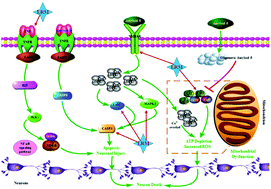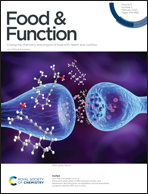Integrated phytochemical analysis based on UHPLC-LTQ–Orbitrap and network pharmacology approaches to explore the potential mechanism of Lycium ruthenicum Murr. for ameliorating Alzheimer's disease†
Abstract
Based on compelling experimental and clinical evidence, the fruit of Lycium ruthenicum Murr. (LRM), a unique traditional Tibetan medicine, exerts beneficial effects on ameliorating learning and memory deficits of Alzheimer's disease (AD) and other neurodegenerative disorders. However, the potential active constituents and biological mechanism of LRM are still unknown. In this study, the major chemical constituents of LRM were first analyzed by ultra-high-pressure liquid chromatography coupled with linear ion trap–Orbitrap tandem mass spectrometry (UHPLC-LTQ–Orbitrap). A total of 35 constituents were confirmed or tentatively identified. Furthermore, the network-based pharmacological strategy was applied to clarify the molecular mechanism of LRM on AD based on the identified components. Totally, 143 major targets were screened and supposed to be effective players in alleviating AD. Then, the LRM chemicals–major LRM putative targets–major pathways network was constructed, implying potential biological function of LRM on AD. More importantly, 12 core genes which can be modulated by LRM were identified, and they may play a pivotal role in alleviating some major symptoms of AD. This study provided a scientific basis for further investigation and application of LRM, which demonstrated that the network pharmacology approach could be a powerful way for the mechanistic studies of folk medicines.



 Please wait while we load your content...
Please wait while we load your content...